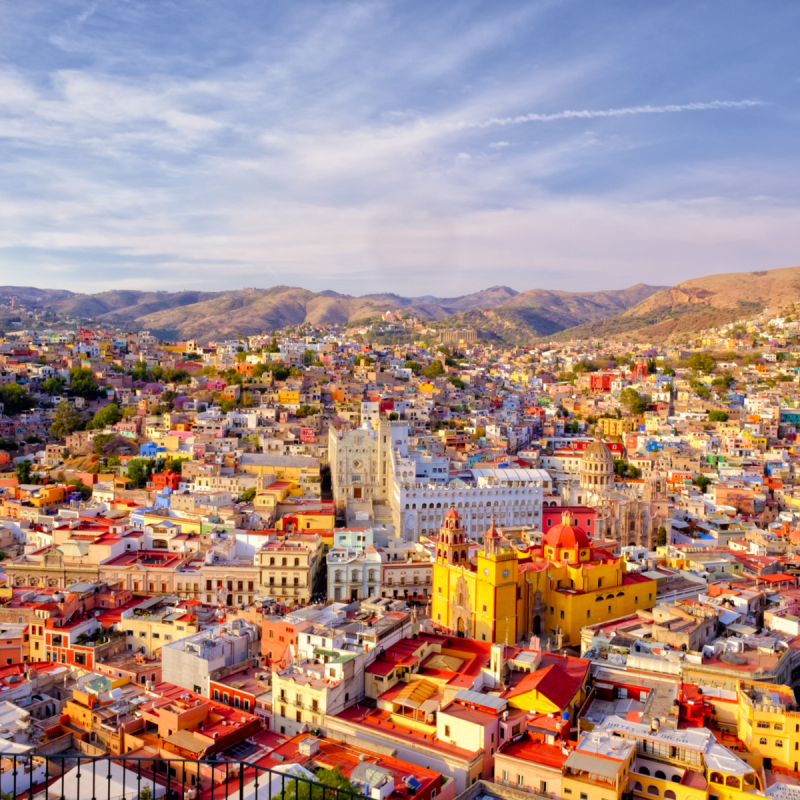
“Mexico is a poor, dangerous backwater country, made up mostly of beaches and hot deserts.” As a part-time expat, I get deeply frustrated hearing the stereotypes people have about my adopted home — a large, diverse country with an extraordinarily rich culture and history.
Videos by TravelAwaits
All cultures arouse stereotypes, but in my experience, Americans have even more misconceptions about their neighboring country than they do about others. After doing careful research, I’ve uncovered some facts that surprised even me.
Here are seven common myths I hope to dispel:

(Photo Credit: Nelson Antoine / Shutterstock.com)
Myth 1: Mexico Is Dangerous
You wouldn’t hesitate to visit New Orleans, right? How about Mexico City? If you’re like many Americans, you think Mexico City is far more dangerous. Yet New Orleans has five times the assault rate as Mexico City, which is also safer than Miami, Philadelphia, Chicago, Washington, D.C., and Atlanta.
The U.S. State Department regularly issues warnings to Americans when traveling to Mexico. I was surprised to read that currently only two of Mexico’s 32 states are considered completely safe to travel in. I wonder how we’d feel if Mexico’s Secretaría de Relaciones Exteriores issued warnings about the U.S.
Of course, Mexico can be dangerous, and it’s particularly unsafe for certain professions (like journalism), because narcotraficos don’t want their strategies exposed. And the drug cartels do indeed fuel violence in some parts of the country, a fact of life in Mexico partly caused by the U.S. drug policy and our ever-growing consumption of illegal narcotics, which drives demand up.
Lax gun laws in the U.S. don’t help. I was amazed to learn that Mexico has only one gun store in the entire country and issues fewer than 50 gun permits a year. But every year, half a million weapons are smuggled into Mexico from the U.S., and many of them end up being used by drug cartels.
It’s highly unlikely, however, that you’ll get caught up in drug violence. If you have any anxiety about safety, search online for local travelers’ or expats’ blogs to give you the current “facts on the ground.”
Myth 2: Mexico Is Poor
The 10th largest country in the world, Mexico has more than 127 million people and an economy ranked 15th globally. Its percentage of middle class citizens is higher than many countries, including some in Europe.
According to data in 2021 from Mexico’s National Statistics Institute (INEGI), 42 percent of Mexico’s households are middle class, which amounts to 39.2 percent of Mexico’s population. It’s even higher in urban areas, at 50.1 percent.
A middle-class household is likely to be composed of a married couple with two children. The head of the household probably has a licenciado (bachelor’s degree) or the equivalent of an associate’s degree from one of Mexico’s universities. The couple usually owns their home and works in the private sector. They own a car, computer, TV, mobile phones, and at least one credit card. Some send their kids to private schools.
One of the painful ironies is that, whereas in the U.S., and especially on the West Coast, homelessness has become the norm, I have never seen a single homeless encampment anywhere in Mexico. The reason is that Mexico’s poor live in slums, which can indeed be squalid — but even a flimsy structure in the slums still provides a roof, and a slum is more permanent with a potentially higher quality of life than a homeless encampment.
Myth 3: Mexicans Are Lazy
According to the Organization for Economic Cooperation and Development (OECD), Mexicans work much more than almost any country in the world — usually because they have to in order to meet their needs. In 2018, Mexicans worked an average of 2,246 hours per year, including part-time jobs, whereas Americans worked 1,783 hours. Germans clock in at the least, at 1,371 hours.

(Photo Credit: Sergio Mendoza Hochmann / Shutterstock.com)
Myth 4: Mexico Is A Backwater Country
I always assumed Mexico was way behind the U.S. in terms of its acceptance of, for example, same-sex marriage and abortion rights. Wrong! A 2021 study showed that 76 percent of the Mexican population supports same-sex marriage, compared to 72 percent in the U.S. The main reason is that 80 percent of Mexicans identify as Catholic, which is much more accepting of same-sex marriage than are evangelicals, a group increasing in the U.S. Mexicans began to support gay rights, too, far earlier than did the U.S., decriminalizing sodomy in 1871, a whopping 124 years before the U.S. did in 2003.
As for abortion, it hasn’t been a crime in Mexico since 2021, although legalization still varies by state. Within a few months, a woman living in the U.S. may find it easier to terminate a pregnancy in Mexico than in her home state — sometimes even for free.
Myth 5: Mexico Is Always Hot
Another common myth about Mexico is that it’s made up primarily of hot, humid beaches and dry, dusty deserts. Sure, some places can be very hot. Oddly, April and May are hotter than July and August, because summer is the rainy season when afternoon thunderstorms, similar to monsoons, cool things off.
Nor is it universally hot in Mexico. The spine of central Mexico, the Altiplano, is a high mesa-like landscape ranging from 5,000–7,000 feet in elevation, with temperatures that range from 60–75 degrees (Fahrenheit) during the day in most months of the year.
And, no, Mexico is not all desert or beach. It’s also rich in rainforests, volcanoes, wetlands, prairies, glaciers, jungles, scrubland, tundra, and steppes.
Myth 6: Mexico’s National Language Is Spanish
While Spanish is the most widely spoken language in Mexico, it’s not the official language. In fact, Mexico doesn’t even have an official language.
Mexico’s percentage of indígenas (Natives), one-third, is the largest of any Western Hemisphere nation. The indígenas speak as many as 68 languages, the main ones being Nahuatl, spoken in the states of Puebla and Veracruz; Yucatec Maya; and Mixtec, in the state of Oaxaca.
If you speak only a smattering of Spanish, you’ll be happy to learn what my husband Barry and I discovered when we first started visiting Mexico 40 years ago: It can be easier to communicate with indígenas than mestizos (mixed race and by far most Mexicans), because Spanish is the second language of the indígenas, too.

(Photo Credit: javarman / Shutterstock.com)
Myth 7: Higher Education In Mexico Is Second-Rate
Once again, I was wrong assuming that higher education in Mexico must be mediocre. In 2022, the National Autonomous University of Mexico (UNAM) ranked 105th out of 1,300 universities in the world. In Latin America, it ranks second only to the University of Buenos Aires. Meanwhile, the Tecnológico de Monterrey, Mexico’s MIT, has been ranked in the top 200 out of 1,673 prestigious universities in the world for the fifth consecutive year.
Until I began living in Mexico, I also didn’t realize that while university students have to pay for add-ons, like housing, food, textbooks, and their actual diploma, tuition itself is completely free. Not only that, but the Mexican government is very generous with becas, or scholarships. Many of our Spanish teachers spent a couple of semesters studying in Europe or the U.S., fully paid for by the Mexican government.
I love my second home with all my heart, and I want you to as well. Now that all our mistaken assumptions are hopefully out of the way, ¡Ven a visitar! (come visit!). Mexicans will welcome you with open arms.
If this hasn’t sold you on a trip to Mexico, these articles surely will:
